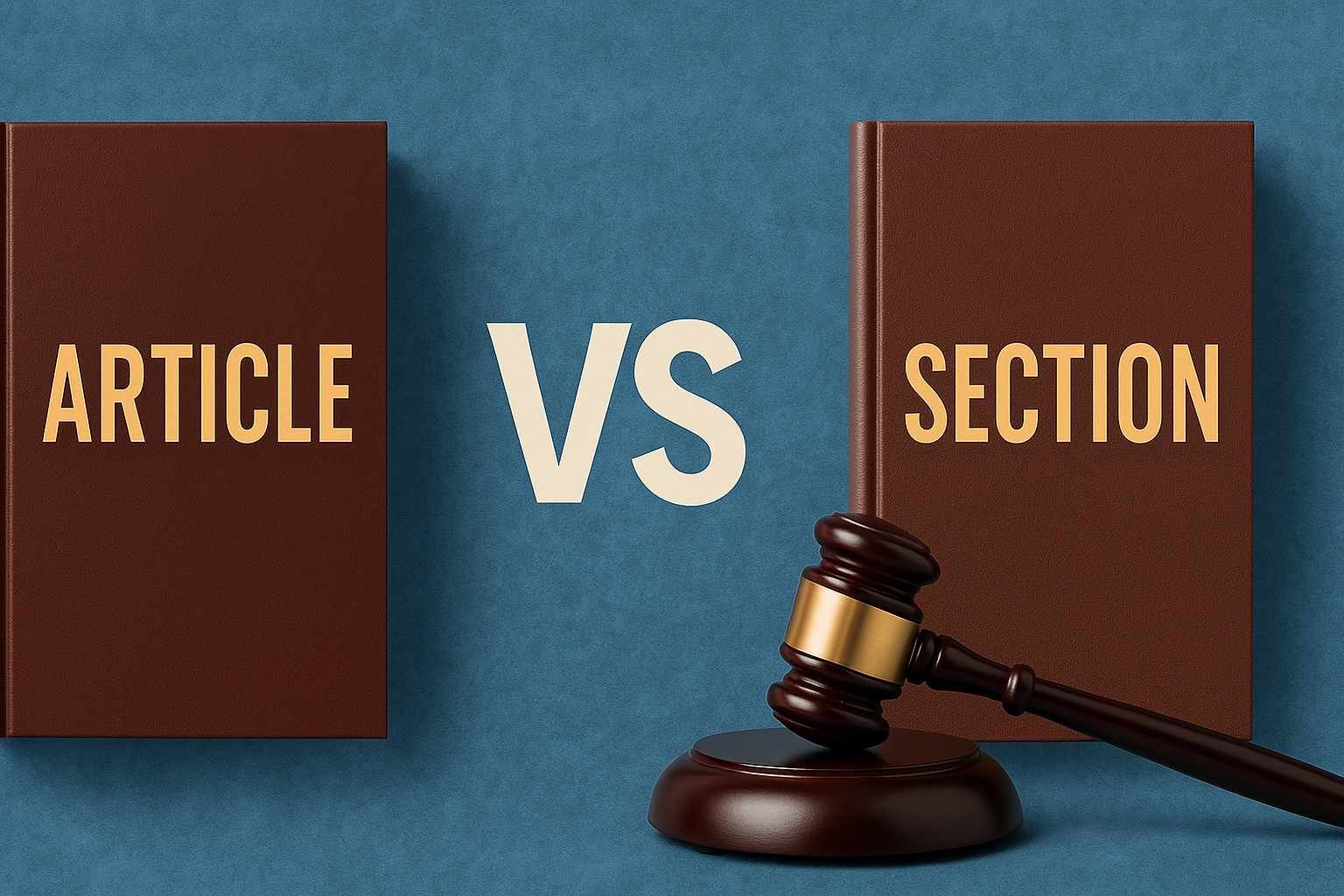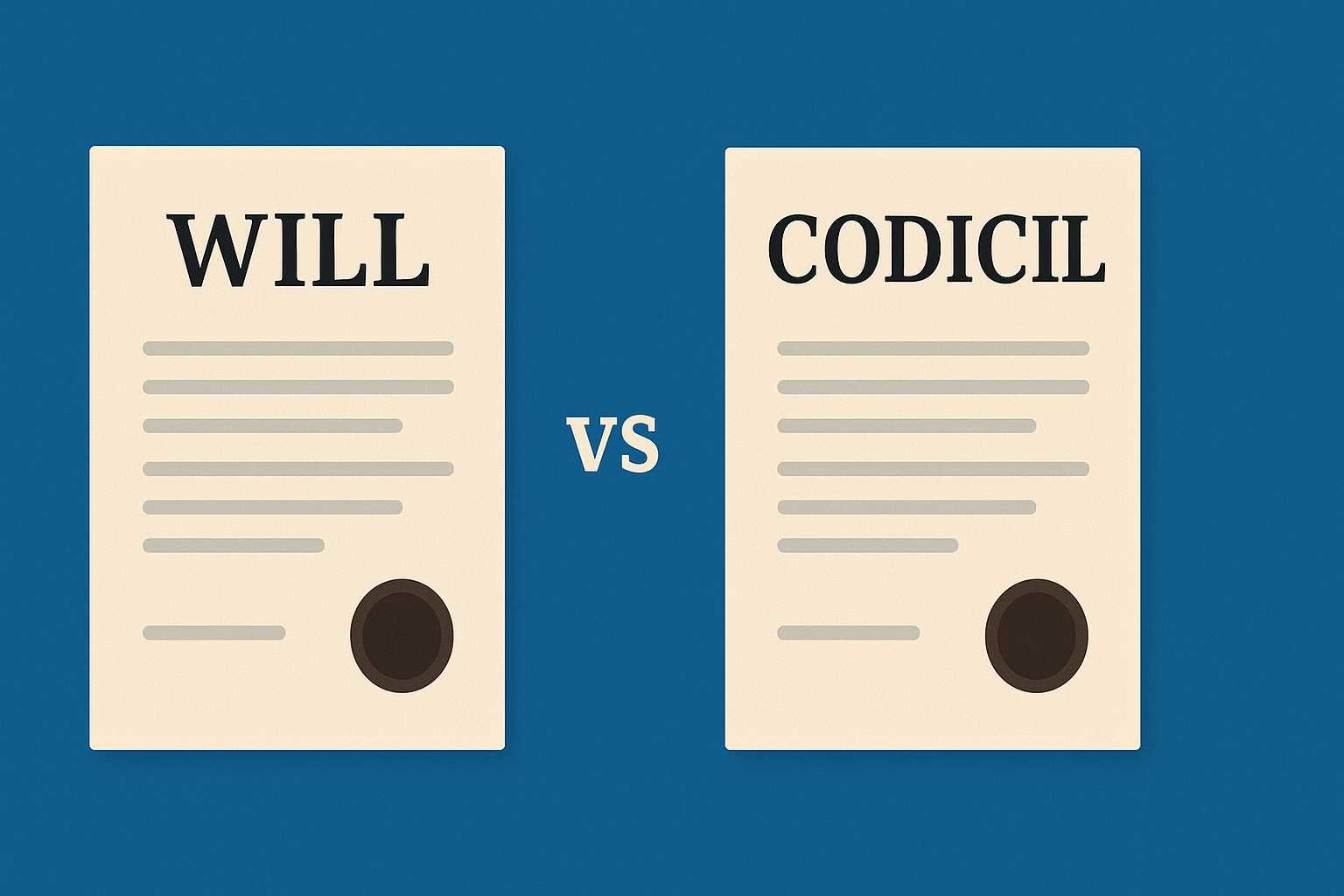On this page you will read detailed information about Difference Between Article and Section
When studying law, constitutions, or statutes, you often encounter two terms — Article and Section. Both are essential structural elements of legal documents, but they are not interchangeable. They serve different purposes, are used in different types of laws, and follow separate interpretive principles.
Understanding the difference between an Article and a Section is crucial for law students, legal professionals, and anyone who wants to correctly interpret constitutional or statutory provisions. This blog explains their meaning, usage, scope, examples, and distinctions, supported by Indian legal references and updated terminology.
1. Meaning of Article
An Article is a distinct and numbered provision within a Constitution or international treaty. It expresses broad principles, rights, or powers at a higher level of governance.
In India, Articles form part of the Constitution of India, 1950, which is the supreme law of the land. Each Article deals with a specific constitutional matter, such as fundamental rights, duties, legislative powers, or the functioning of institutions.
Legal Definition
There is no formal statutory definition of “Article” in Indian law, but in constitutional context, an Article refers to a numbered paragraph or clause that deals with a distinct subject or principle of constitutional importance.
Example
- Article 14 – Guarantees equality before the law and equal protection of laws.
- Article 19(1)(a) – Grants the right to freedom of speech and expression.
- Article 370 – (Now repealed) dealt with special status for Jammu & Kashmir.
- Article 280 – Establishes the Finance Commission.
Characteristics of an Article
- Belongs to a Constitution or Treaty: Articles appear in founding documents like the Constitution of India, UN Charter, etc.
- Broad in Nature: They express fundamental legal principles rather than procedural details.
- Supreme Authority: Constitutional Articles override all other laws in case of conflict.
- Framework-Based: They form the skeleton of governance — defining institutions, distribution of power, and citizen rights.
- Interpretation by Higher Courts: Articles are interpreted by the Supreme Court or Constitutional Benches due to their wide and foundational scope.
2. Meaning of Section
A Section is a specific, numbered provision in a statute or Act that lays down detailed rules, procedures, penalties, or definitions.
Unlike Articles (which belong to the Constitution), Sections belong to ordinary laws or legislations passed by Parliament or State Legislatures.
Legal Definition
A “Section” is a division of a statute or enactment, often containing detailed legal directions or prohibitions.
Every Act passed by Parliament—like the Indian Penal Code (IPC), Companies Act, or Income Tax Act—is divided into sections for clarity and organization.
Example
- Section 302, IPC – Punishment for murder.
- Section 144, CrPC – Power to issue orders in urgent cases of nuisance or danger.
- Section 7, Companies Act, 2013 – Incorporation of company.
- Section 80C, Income Tax Act, 1961 – Deductions for certain investments.
Characteristics of a Section
- Belongs to Statutory Laws: Found in Acts, Codes, and Ordinances.
- Precise and Detailed: Each section covers a specific rule or punishment.
- Subordinate to the Constitution: Sections must conform to constitutional provisions.
- Can Have Sub-sections and Clauses: For example, Section 420(1)(b).
- Interpreted by All Courts: Including trial courts, high courts, and tribunals.
3. Key Differences Between Article and Section
| Basis | Article | Section |
|---|---|---|
| Meaning | A numbered provision in the Constitution or treaty expressing broad principles or powers. | A numbered provision in a statute or Act explaining specific rules, offences, or procedures. |
| Legal Document Type | Found in the Constitution or international legal documents. | Found in laws enacted by Parliament or State Legislatures. |
| Scope | Deals with constitutional or fundamental principles. | Deals with statutory implementation and details. |
| Hierarchy | Supreme — all laws must conform to Articles. | Subordinate to the Constitution. |
| Authority | Interpreted by higher constitutional courts (mainly Supreme Court). | Interpreted by any competent court depending on jurisdiction. |
| Nature | Broad, general, and principle-based. | Specific, detailed, and procedural. |
| Example | Article 21 – Right to life and personal liberty. | Section 302, IPC – Punishment for murder. |
| Amendment | Amended through Article 368 (Constitutional Amendment Procedure). | Amended by simple legislative process in Parliament or State Assembly. |
| Application | Applicable nationwide as constitutional law. | Applicable as per the jurisdiction of the specific statute. |
| Dependency | Self-contained – forms part of the supreme legal document. | Dependent on the parent Act for context and meaning. |
4. Relationship Between Articles and Sections
Although Articles and Sections are distinct, they are interconnected in India’s legal framework.
- Articles provide the constitutional foundation for making laws.
- Sections are the operational tools that give effect to those constitutional principles.
For example:
- Article 21 guarantees the right to life.
- The Indian Penal Code (Sections 299–304) and Criminal Procedure Code (Sections 41–438) operationalize this right by defining offences and procedures that protect life and liberty.
Similarly:
- Article 246 divides legislative powers between Parliament and State Legislatures.
- Based on this division, various Acts with Sections (like the Motor Vehicles Act, Labour Codes, etc.) are enacted under specific constitutional authority.
Thus, Articles represent the spirit of the law, while Sections represent its execution.
5. Example of Usage in Indian Legal Context
(a) Constitution of India
The Constitution consists of 470 Articles divided into 25 Parts and 12 Schedules.
Each Article covers a fundamental aspect:
- Part III: Fundamental Rights (Articles 12–35)
- Part IV: Directive Principles of State Policy (Articles 36–51)
- Part V: The Union Government (Articles 52–151)
(b) Indian Penal Code, 1860
The IPC contains 511 Sections, each dealing with specific offences and penalties.
Examples:
- Section 120B – Criminal conspiracy.
- Section 420 – Cheating.
- Section 376 – Punishment for rape.
Thus, Articles define the structure of justice and governance, while Sections implement that structure through detailed laws.
In the previous post, we had shared information about Difference Between Will and Codicil, so read that post also.
6. Interpretation of Articles vs Sections
(a) Interpretation of Articles
Articles are interpreted liberally and purposively because they represent constitutional principles.
For instance:
- Article 21 (“Right to life”) has been expansively interpreted by the Supreme Court to include the right to privacy, clean environment, and dignified life.
- Courts often use constitutional morality and intent to interpret Articles.
(b) Interpretation of Sections
Sections are interpreted strictly and literally, especially in criminal or tax laws, where ambiguity can lead to injustice.
However, in welfare or labor laws, a liberal interpretation is applied to protect beneficiaries.
7. How Are They Created or Amended?
Articles (Constitutional Provisions)
- Created during the Constituent Assembly (1946–1949) drafting process.
- Amended only through the Constitutional Amendment process (Article 368), which requires a special majority and, in some cases, ratification by states.
Example:
- The 104th Constitutional Amendment (2020) extended the reservation for SC/ST in Lok Sabha and State Assemblies.
Sections (Statutory Provisions)
- Created by Parliamentary or State legislation under Article 245 and 246.
- Amended by ordinary legislative process, requiring a simple majority in the respective house.
Example:
- Criminal Laws (Amendment) Act, 2013 amended multiple IPC Sections, including Section 376, to strengthen laws against sexual offences.
8. Common Misunderstandings
- “Articles exist in every law.”
❌ Wrong. Articles exist mainly in Constitutions and international treaties, not in ordinary Acts. - “Sections can override Articles.”
❌ Incorrect. Articles are supreme — if a Section violates an Article (e.g., fundamental rights), it can be struck down by the judiciary under Article 13. - “Articles are procedural.”
❌ No. Articles are principle-based, while Sections deal with procedure and implementation. - “Both are amended similarly.”
❌ Constitutional Articles need special procedures, while statutory Sections can be amended by ordinary legislation.
9. Real-World Relevance (2023–2025 Context)
Recent constitutional and legislative updates demonstrate the interplay between Articles and Sections:
- 2023: The Supreme Court upheld constitutional validity of the 103rd Amendment (EWS reservation) under Article 15(6) and Article 16(6).
- 2024–25: Amendments to Criminal Procedure Code (now Bharatiya Nagarik Suraksha Sanhita) changed multiple sections to modernize criminal justice.
These examples show how Articles empower Parliament to legislate, while Sections bring those Articles to life.
Conclusion
In essence, Articles and Sections are two fundamental building blocks of the Indian legal system — one represents constitutional vision, while the other ensures statutory execution.
An Article lays down the broad principles of governance, rights, and power distribution, forming the bedrock of law. A Section, on the other hand, provides the detailed, enforceable framework that gives practical effect to those principles.
Understanding their distinction is vital not only for legal accuracy but also for appreciating how India’s democratic and judicial systems function cohesively — where Articles guide and Sections implement the rule of law.
Disclaimer
The information and services on this website are not intended to and shall not be used as legal advice. You should consult a Legal Professional for any legal or solicited advice. While we have good faith and our own independent research to every information listed on the website and do our best to ensure that the data provided is accurate. However, we do not guarantee the information provided is accurate and make no representation or warranty of any kind, express or implied, regarding the accuracy, adequacy, validity, reliability, availability, or completeness of any information on the Site. UNDER NO CIRCUMSTANCES SHALL WE HAVE ANY LIABILITY TO YOU FOR ANY LOSS OR DAMAGE OF ANY KIND INCURRED AS A RESULT OR RELIANCE ON ANY INFORMATION PROVIDED ON THE SITE. YOUR USE OF THE SITE AND YOUR RELIANCE ON ANY INFORMATION ON THE SITE IS SOLELY AT YOUR OWN RISK. Comments on this website are the sole responsibility of their writers so the accuracy, completeness, veracity, honesty, factuality and politeness of comments are not guaranteed.
So friends, today we talked about Difference Between Article and Section, hope you liked our post.
If you liked the information about Difference Between Article and Section, then definitely share this article with your friends.
Knowing about laws can make you feel super smart ! If you find value in the content you may consider joining our not for profit Legal Community ! You can ask unlimited questions on WhatsApp and get answers. You can DM or send your name & number to 8208309918 on WhatsApp






